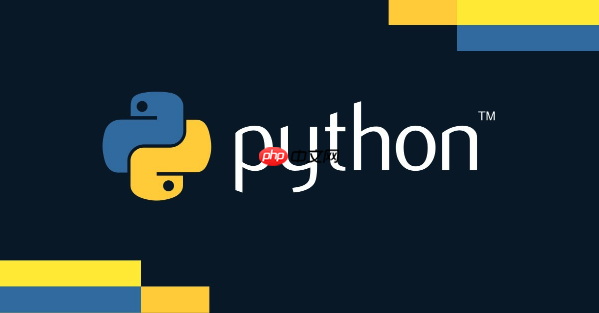生成器函数与普通函数的本质区别在于:普通函数执行后返回值并销毁状态,而生成器函数通过yield暂停并保持状态,返回生成器对象实现惰性求值和内存高效迭代。

python中的生成器函数和
yield
关键字,是处理大量数据或构建高效迭代器时非常强大的工具。它们的核心思想在于“按需生成”数据,而不是一次性将所有数据加载到内存中,这在很多场景下能显著提升性能和资源利用率。简单来说,
yield
让一个函数能够暂停执行并返回一个值,然后在下次需要时从暂停的地方继续执行。
当我第一次接触
yield
的时候,说实话,感觉有点“反直觉”。我们习惯了函数执行到
return
就彻底结束,但
yield
完全打破了这个模式。一个函数如果包含了
yield
语句,它就不再是一个普通的函数,而变成了一个生成器函数。调用它并不会立即执行函数体,而是返回一个生成器对象。这个对象才是真正可迭代的。
每次我们从生成器对象中请求下一个值(比如通过
循环或者手动调用
next()
),生成器函数就会从上次暂停的地方继续执行,直到遇到下一个
yield
语句,再次暂停并“吐出”一个值。当函数体执行完毕,或者遇到
return
(在生成器中
return
会终止迭代,并可选地返回一个值,但通常我们不这么用),生成器就会抛出
StopIteration
异常,表示没有更多的数据了。
这种“惰性求值”的机制,是我认为
yield
最迷人的地方。想象一下,你要处理一个几GB甚至几十GB的文件,如果一次性读入内存,你的程序可能直接就崩溃了。但用生成器,你可以一行一行地读取、处理,每次只占用极少的内存。
立即学习“Python免费学习笔记(深入)”;
# 一个简单的生成器函数示例 def my_range(n): i = 0 while i < n: yield i i += 1 # 使用生成器 print("通过for循环迭代:") for num in my_range(5): print(num) print("n手动通过next()获取:") gen = my_range(3) print(next(gen)) # 输出 0 print(next(gen)) # 输出 1 print(next(gen)) # 输出 2 try: print(next(gen)) # 尝试获取第四个值,会触发StopIteration except StopIteration: print("迭代结束了!")
你看,它就像一个聪明的工厂,不是一次性生产所有产品,而是接到订单才生产一个,然后等着下一个订单。
Python生成器函数与普通函数有何本质区别?
我觉得理解生成器和普通函数的核心差异,是掌握
yield
的关键一步。最直观的区别在于,普通函数执行到
return
语句后,会立即终止,并将
return
后的值(或
None
)作为结果返回给调用者。函数的局部变量和执行状态都会被销毁。
而生成器函数,它遇到
yield
后,会暂停当前的执行,将
yield
后面的值返回。但关键在于,它会“记住”当前的执行状态——包括所有的局部变量和执行到哪一行。下次调用它时,它会从上次暂停的地方继续执行,而不是从头开始。这就像你读一本小说,读到一半合上书,下次打开时能直接从上次的章节继续读,而不是每次都从第一页开始。
从技术层面讲,普通函数返回的是一个具体的值,而生成器函数返回的是一个迭代器(或者说生成器对象),这个对象实现了迭代器协议(即有
__iter__
和
__next__
方法)。这意味着你可以用
for
循环去遍历它,或者用
next()
函数逐个获取值。这种差异,直接决定了它们在内存管理和处理大型数据集时的效率天壤之别。
在哪些实际场景下,我们应该优先考虑使用Python生成器?
我个人在使用Python处理数据时,一旦发现需要迭代处理大量数据,或者数据源是流式的、无限的,我几乎会本能地想到生成器。
-
处理大型文件或数据集: 这是最典型的应用场景。比如你需要读取一个日志文件,分析其中包含特定关键字的行。如果文件有几十GB,你不可能一次性读入内存。用生成器,你可以逐行读取,逐行处理,内存占用始终保持在一个非常低的水平。
def read_large_file(filepath): # 实际应用中,这里应该处理文件不存在等异常 try: with open(filepath, 'r', encoding='utf-8') as f: for line in f: yield line.strip() except FileNotFoundError: print(f"文件未找到: {filepath}") # 可以选择抛出异常或返回空生成器 return # 假设有一个很大的'access.log'文件 # 创建一个模拟的大文件 with open('test_access.log', 'w') as f: for i in range(10000): f.write(f"Line {i}: This is a log entry. {'ERROR' if i % 100 == 0 else ''}n") print("n处理模拟日志文件:") for log_entry in read_large_file('test_access.log'): if "ERROR" in log_entry: print(f"发现错误日志: {log_entry}") -
生成无限序列: 比如斐波那契数列,或者一个计数器。你无法一次性生成所有这些数字,因为它们是无限的。生成器可以按需提供。
def fibonacci_sequence(): a, b = 0, 1 while True: # 无限循环,因为斐波那契数列是无限的 yield a a, b = b, a + b print("n生成斐波那契数列的前10个数字:") fib_gen = fibonacci_sequence() for _ in range(10): print(next(fib_gen)) # 打印前10个斐波那契数 -
数据管道和流式处理: 当你需要对数据进行一系列转换时,生成器可以构建一个高效的“管道”。每个生成器函数负责一个步骤,数据在管道中流动,每次只处理一小块,而不是在每个步骤都创建中间列表。
def filter_evens(numbers): for num in numbers: if num % 2 == 0: yield num def square_numbers(numbers): for num in numbers: yield num * num data = [1, 2, 3, 4, 5, 6, 7, 8, 9, 10] # 传统方式可能需要创建中间列表,占用更多内存 # evens = [n for n in data if n % 2 == 0] # squared_evens = [n*n for n in evens] # 生成器管道 print("n通过生成器管道处理数据:") processed_data = square_numbers(filter_evens(data)) for res in processed_data: print(res) # 输出 4, 16, 36, 64, 100
这种链式调用,在我看来,不仅高效,代码也更清晰。
Python中的生成器表达式(Generator Expression)是什么?它与生成器函数有何异同?
当我们谈到生成器时,除了生成器函数,还有一个非常简洁且同样强大的工具——生成器表达式。我常常把它看作是列表推导式(List Comprehension)的“惰性”版本。
生成器表达式的语法非常像列表推导式,只是它使用圆括号
()
而不是方括号
[]
。
# 列表推导式:立即创建一个包含所有元素的列表 # my_list = [x * x for x in range(1000000)] # 会立即占用大量内存,慎用大范围 # 生成器表达式:创建一个生成器对象,按需生成值 my_gen_exp = (x * x for x in range(1000000)) # 几乎不占用内存,直到你迭代它 print("n生成器表达式示例:") print(f"生成器表达式对象: {my_gen_exp}") print(f"第一个值: {next(my_gen_exp)}") # 输出 0 print(f"第二个值: {next(my_gen_exp)}") # 输出 1 # 我们可以继续迭代 for _ in range(3): print(next(my_gen_exp)) # 输出 4, 9, 16
区别:
- 语法: 生成器函数使用
def
定义和
yield
关键字;生成器表达式是类似推导式的单行语法,用圆括号包裹。
- 返回类型: 生成器函数返回一个生成器对象;生成器表达式直接生成一个生成器对象。
- 复杂性: 生成器函数可以包含多行逻辑、条件判断、循环甚至异常处理,适合复杂的逻辑;生成器表达式更适合简单的、单行可表达的转换或过滤操作。
- 重用性: 生成器函数可以有参数,可以被多次调用以创建新的生成器实例;生成器表达式通常是即时创建,如果需要多次迭代同一个逻辑,可能需要重新创建表达式(或者将其封装到函数中)。
相同点:
- 惰性求值: 两者都实现了惰性求值,按需生成数据,而不是一次性生成所有数据。
- 内存效率: 都非常内存高效,尤其是在处理大型数据集时。
- 迭代器协议: 两者都返回实现了迭代器协议的对象,可以被
for
循环遍历,或通过
next()
获取值。
在我看来,如果你需要一个简单的、一次性的迭代器,生成器表达式是优雅且高效的选择。但如果逻辑更复杂,或者你需要封装更强的复用性,那么生成器函数无疑是更好的工具。选择哪一个,更多时候取决于你代码的复杂度和可读性需求。


评论(已关闭)
评论已关闭